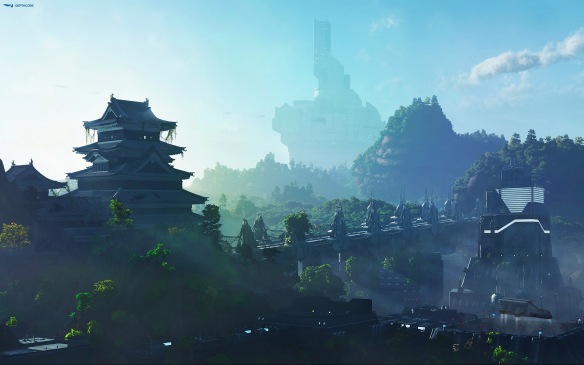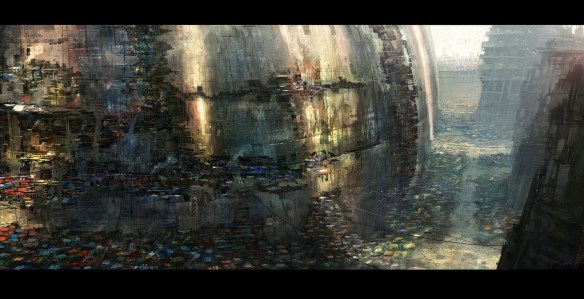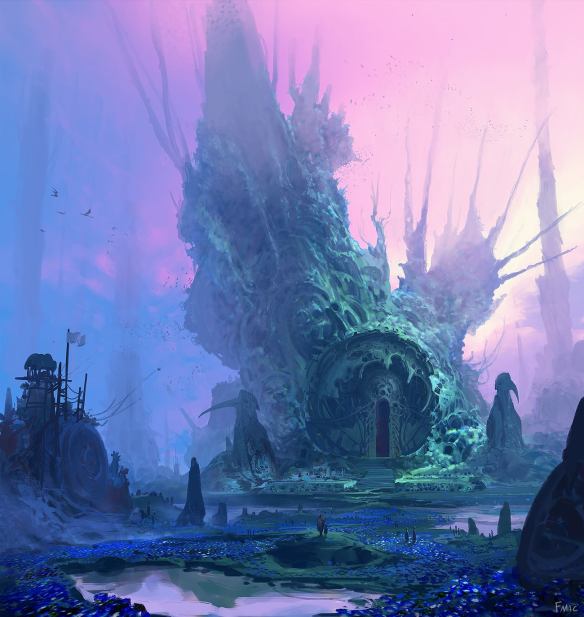
This quote is from the first volume of the original Dungeons & Dragons:
DUNGEONS and DRAGONS will provide a basically complete, nearly endless campaign of all levels of fantastic-medieval wargame play. Actually, the scope need not be restricted to the medieval; it can stretch from the prehistoric to the imagined future…
–Dungeons and Dragons: Book 1 Men & Magic
Dave Arneson and Gary Gygax
Please note how extraordinary this quote is in the context of what people came to think of Dungeons & Dragons as over time. What was originally designed to being a framework to play any setting ended up a vaguely Tolkienesque default setting in the imaginations of most people.
Some thoughts:
As noted elsewhere, Traveller grew distinctly out of the roots of Dungeons & Dragons.
Here are the opening sentences from the last page of Traveller Book 3 (1981) under the heading A Final Word:
Traveller is necessarily a framework describing the barest of essentials for an infinite universe; obviously rules which could cover every aspect of every possible action would be far larger than these three booklets. A group involved in playing a scenario or campaign can make their adventures more elaborate, more detailed, more interesting, with the input of a great deal of imagination.
The greatest burden, of course, falls on the referee, who must create entire worlds and societies through which the players will roam. One very interesting source of assistance for this task is the existing science-fiction literature. Virtually anything mentioned in a story or article can be transferred to the Traveller environment. Orbital cities, nuclear war, alien societies, puzzles, enigmas, absolutely anything can occur, with imagination being the only limit.
Please note the echo of the sensibility in this quote to the quote from Dungeons & Dragons above.
Note now this observation from Geoffrey McKinney in a post at the Lamentations of the Flame Princess site.
Ever since the 1970s, people have typically failed to distinguish between A) the D&D game and B) the sample playing pieces included with the game. Just about every D&D product is full of monsters from the standard lists, magic items from the standard lists, spells from the standard lists, and etc. I think that shows a reticence to really unleash the imagination.
I would say this observation is accurate. And I would say it is just as accurate as an observation of what happened with Traveller over the years.

Traveller has been called an RPG Toolkit, an assessment I agree with.
You can open up Traveller Books 1-3 and construct from simple, flexible rules the setting and game you want.
Yes, there are implied setting elements. For example, communication only moves at the speed of travel. There is a military of some sort which trains the PCs before they launch their life of adventure. There is trade between the stars. Interstellar travel is dangerous in the portions of space where the game establishes play. And so on…
But even with these details questions must be asked and answer: What is on those worlds? Are there aliens? Is there high tech? Are they primitive? How closely aligned politically are worlds that are near each other? Are they at war with each other? In different to each other? How much travel takes place between them? Is the area relatively at peace? What sorts of technology astounds the average space-farer? How big are the starships? And so on.
And as the quote from Miller above states clearly, that was the original concept from the beginning. You were expected to make your own setting, since no setting was provided in Traveller Books 1-3. This means there is no Third Imperium, no Official Traveller Universe.
That GDW developed the Third Imperium over the following years, and that Traveller the game became conflated with the Third Imperium the setting over time is another matter entirely. Please note that this series of posts is all about what is found if one uses Traveller Books 1-3 as the bedrock for play, and ignores any concerns for GDW’s official setting. Note that this premise is founded on all of the quotes found above.
As Marc Miller said in an interview at Citizens of the Imperium:
Remember that the original concept for Traveller was very GURPS-ish: a generic system that could emulate every possible part of SF. And in the first year, we did very little support beyond the basic rules. It was only after we started writing adventures that the Imperium started taking shape as a real background.
This post, and the other posts in this series, works from the point of view of the original concept of Traveller, as Miller describes above.

Traveller, then, is a framework of rules as tools to build the science fiction setting you want. It has suggestions for the implied setting in some of the rules, but even these rules can be discarded to use the “rules as tools” to build the setting you want.
From the post just linked in the previous paragraph, here at the “sample playing pieces” (as McKinney refers to them) from Books 1-3:
Traveller Tools of Play
- Character creation
- Personal combat rules
- Space combat rules
- A skill system with a specific and limited list of skills*
- Random Rumor Tables
- Random person encounter tables
- Encounter range tables
- Reaction tables
- Random animal encounter table
- Patron encounter table
- Starship encounter table
- Generating a Subsector
- Generating system Main Worlds (UWP)
- The various values of the UWP
- Generating space lanes (1977 Edition)
- Starship expenses tables
- Starship income tables
- Experience rules
- Psyonic rules
- Drugs and their effects on other rules
- Weapons, vehicles, and equipment with effects on other rules
- Ship component/construction tables
But here are the questions (or some of them):
What are psionics in your setting? Does there have to be a Psionics Institute per Book 3? (A rhetorical question. The answer is: no.) Could you rebuild the “playing pieces” to build a mystical religion like the Bene Gesserit from Dune? The Force from Star Wars?
The answers are: Yes.
How does Jump Technology work? Could you meld Jump Technology with psionic training? Yes, yes you could. Could you make the fuel much more difficult to find? Yes, yes you could. Could you make the Jump technology more efficient? Yes. Can you set the upper limit on Tech Levels in your setting, so that Jump-2, Jump-3, or Jump-4, respectively, are the max jumps allowed in your setting. Yes.
Free Traders are supposed to have mortgage payments. Is that the only way to use financing and get the PCs into ships? Could a noble give a patent to the PCs, allowing them access to a ship as long as they are doing his bidding of espionage or piracy while plying the stars? Absolutely. Could nobility, and not banks, be the institution that controls ship building and finance? Yes… if that’s what you wanted.
Do you need to roll all Universal World Profiles randomly? (No. And the rules state this explicitly.) You could, if you wished, create the worlds as you wished, using the UWP as a notation as you go.
Are you able to come up with your own starship designs? New weapons? New technologies? Alien races? And so on…
Absolutely. You should. That was the point of the game.
All of this is a reminder that what is in Books 1-3 is there as a framework of play, to get things going for the Referee and Players. But that over time the group should be reworking and tweaking to their hearts content. The “playing pieces” of psionics and jump drives and Tech Levels and ship sizes and the Universal Personality Profiles and so on are there to be manipulated as you wish to make the setting and play experience you wanted. You can leave mortgages on ships out if you wish. You can dispense with patrons and only use rumor tables.
I want to make it clear that something wonderful happened to RPGs over the last decade and a half: they became clearer and more complete.
But there was a different way of publishing an RPG from the ’70s…. a method that was not at all complete, but equally valid, that allowed you create what you wanted with a simple set of rules as tools. I encourage everyone approaching Traveller Books 1-3 to approach them with his point of view.
Do not let these tools define your setting. Use the tools to build your setting.

Reblogged this on Tome and Tomb.
I must have found your blog after this was published as I don’t remember this post. However I felt I needed to leave a comment to say: ‘Hear hear’!
Funny the same thing happened to runequest. Original (2nd ed) RQ by Perrin was a mechanism for playing IN Staffords Glorantha, and was only 80 pages including a fair bit of world and setting stuff.
The newest RQG is 400 pages, not nearly as tightly written, misses some stuff, and LOCKS the game not only into the setting but into a single region (!) precluding the variety of locations that grew from the universality of the former rules, and directly deprecates the “same rules and state for players and monsters” that made the original system unique.
In fact I got into some argument about this with Jeff Richards, as I suggested a more rules mechanics core book with setting focused campaign supplements and was roundly criticized (I think?) for wanting the new RQ to be too much like a wargame.
It may not surprise you to find that I agree with your observations about Runequest.